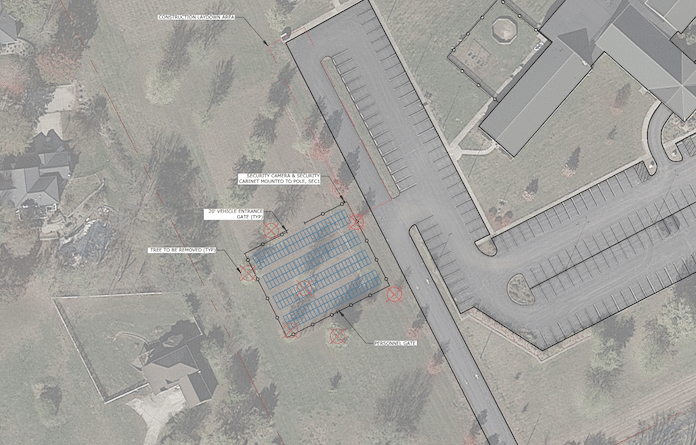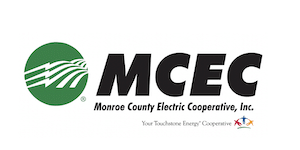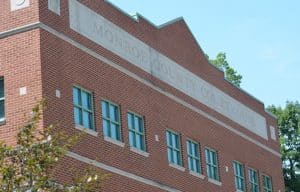Solar flare in Columbia

Echoing an Aug. 4 meeting, discussion of a proposed solar project once again lasted nearly an hour on the top floor of Columbia City Hall Monday night.
Members of Christ Community Lutheran Church and neighboring property owners packed City Hall ahead of an expected vote on a special use permit for a ground-mounted solar array at 1 Christchurch Way, located near Gall Road just south of Oerter Park.
During the Aug. 4 city council meeting, church leaders spoke during public comment to shed light on the decision making involved in the project and to explain why some suggested alternatives were not feasible.
Monday’s meeting seemed to be more of a mass appeal by those involved with the church as a last-ditch attempt to save a project for which the church has already invested money in related equipment in an effort to avoid expected price hikes due to international federal tariffs announced at the beginning of this year.
The council’s ultimate decision was to refer the matter back to the Columbia Planning Commission to give the church leaders an opportunity to develop adjustments to ease concerns of nearby residents; however, the special use process itself has a few congregants scratching their heads on the way back to the drawing board.
Two speakers summed up the general arguments of both sides.
One of the many Christ Community members to speak Monday night was Nathan Rau, who said city officials responded to the permit submission with feedback and suggestions which might help in the approval process.
“The city even says, quote, ‘If you make these changes, it will provide a more straightforward and achievable path forward,’” Rau began, adding city officials offered assistance with the process.
Rau noted an agenda report for the July 14 Columbia Planning Commission meeting found “no fault” with the solar project, also showing “compliance” with city code and its comprehensive plan.
What Rau perceived as smooth sailing quickly became choppy waters as the planning commission voted unanimously to disapprove the special use request.
The commissioners’ reasoning, according to unofficial minutes of the July meeting included in the Aug. 11 commission meeting minutes, was that the ground-mounted array was “not allowed by right,” adding “it is a special use permit for a reason, and there are other options available.”
Rau asked aldermen if they could “imagine the confusion whenever there’s no denial that we meet the code, and we’ve done the changes the city requested, and we still have a strong dead-end with that unanimous vote against our petition.”
Despite fielding questions from aldermen Aug. 4 and further communication after the meeting, Rau said “it still feels like an uphill battle, like we’re still struggling to get a foothold, and I don’t know why.”
He expressed further confusion about one alderman’s comment about “proximity to property lines” despite the church’s project plan being well within setback requirement guidelines.
The church is located on a nearly 25-acre lot with no residential properties along its northern border and only 10 bordering properties to the west and south.
One such resident, Pat Seibel, has lived in the area for over 37 years, and she remarked she watched the church being constructed.
She spoke on her own behalf and also her admittedly small number of neighbors against constructing a solar array near her home.
Part of her comment Monday night included concerns that the solar project “does not fit in the neighborhood,” explaining she understands that consideration of the nearby soccer park and the church’s school students as reasons for planning the arrays closer to the bordering residences.
“They didn’t take into consideration the small number of neighbors… However, I’m a taxpayer, and I’ll be able to see that array from my deck,” Seibel said. “That’s going to be something that I would prefer the green space, as I’m sure my neighbors do.”
She continued by countering those who asked her to consider what it would be like to be in the aldermen’s “shoes,” saying those people should consider being in her and her neighbor’s position.
“Having this next to your house, I have a feeling that anyone here would feel a little bit different about that,” she continued.
After church leaders discussed other options and technical aspects of solar installations involved in the special use language, Columbia City Attorney Terry Bruckert reminded aldermen they had the option to refer it back to the planning commission rather than to deny the permit outright.
Several aldermen found wisdom in that suggestion, with Ward II Alderman Michael Lawlor stating he would have voted yes to the permit if everyone were in agreement, but could likely vote no with some issues seemingly unresolved.
The controversy over solar arrays in Columbia is a microcosm of similar situations in Monroe County and throughout Illinois following Illinois lawmakers bolstering solar incentives earlier this year.
A proposal to create an array on a 117-acre undeveloped property in rural Waterloo generated buzz on social media and in the local coffee clubs when it was submitted to the county’s zoning department twice, only to be rescinded prior to each Monroe County Plan Commission meeting.
The county solar farm is expected to be resubmitted before the end of the year.
As for the future of the Columbia church’s solar array, the planning commission is expected to review an amended permit request during a meeting in the next few months, depending on how negotiations between the church and property owners progress.
The main action item of the evening was approval of a 1 percent grocery tax extension for city businesses.
The tax, already approved by a number of county municipalities, continues a longstanding state tax which lawmakers announced would end at the beginning of 2026.
Local governing bodies were allowed to approve the tax without a public vote if it were reinstated prior to Oct. 1.
Columbia aldermen voted unanimously to reinstate the tax.
While the solar discussion has lasted nearly two hours over two council meeting, Monday’s vote and consideration of the tax item Aug. 4 garnered virtually no discussion from officials or public comment.
Another action item was the awarding of a pavement striping bid, but a follow-up question for Columbia City Engineer Chris Smith refocused everyone’s attention.
Smith said the city will submit plans to repair a washed out Valmeyer Road – which has been closed since April – to the Illinois Department of Natural Resources by this Friday.
Smith reiterated the complications and additional regulation which arise in the event a federally-recognized tributary is involved in a project.
One such waterway, Carr Creek, is partly responsible for the Valmeyer Road collapse earlier this year which has kept the thoroughfare closed from D Road to Bluff Road for nearly five months.
While the process is finally moving, Smith offered little hope Valmeyer Road would be open in the near future.
“Once we get some sort of concurrence that what is being submitted is going to work, we need to have a further conversation on how to implement it and procure it,” Smith said.
“There’s a couple different options to consider.”
On a positive note, Smith noted much of the work when the repair project begins will be from the “park side,” meaning traffic control will be easier to coordinate during work.
The next meeting of the Columbia City Council is Tuesday, Sept. 2, beginning at 6:30 p.m. at City Hall.






